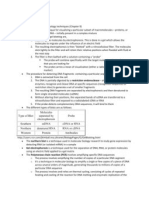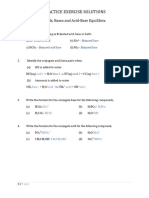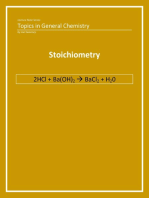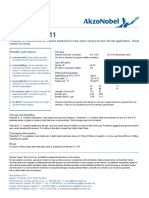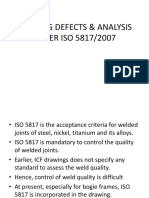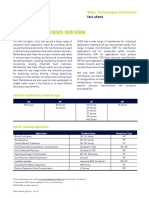Chemistry Teach Yourself Series - Topic 1 - PH
Chemistry Teach Yourself Series - Topic 1 - PH
Uploaded by
Mia FENTONCopyright:
Available Formats
Chemistry Teach Yourself Series - Topic 1 - PH
Chemistry Teach Yourself Series - Topic 1 - PH
Uploaded by
Mia FENTONOriginal Title
Copyright
Available Formats
Share this document
Did you find this document useful?
Is this content inappropriate?
Copyright:
Available Formats
Chemistry Teach Yourself Series - Topic 1 - PH
Chemistry Teach Yourself Series - Topic 1 - PH
Uploaded by
Mia FENTONCopyright:
Available Formats
Chemistry Teach Yourself Series
Topic 1: pH
Author: Pat O’Shea
A: Level 14, 474 Flinders Street Melbourne VIC 3000
T: 1300 134 518 W: tssm.com.au E: info@tssm.com.au
© TSSM 2010 Page 1 of 11
Contents
pH formula: Derivation of formula................................................................................................................ 3
pH of strong acids .......................................................................................................................................... 4
Alkaline solutions .......................................................................................................................................... 6
pH of weak acids ........................................................................................................................................... 8
Solutions to Questions ................................................................................................................................. 10
© TSSM 2010 Page 2 of 11
pH
What is it?: a measure of the acidity or alkalinity of a solution.
pH = − log 10 [ H 3O + ]
pH formula: Derivation of formula
Unit 2 Chemistry
HCl(aq) + H2O(l) H3O+(aq) + Cl --(aq)
HNO3(aq) + H2O(l) H3O+(aq) + NO3--(aq)
+ --
CH3COOH(l) + H2O(l) H3O (aq) + CH3COO (aq)
Acid definition. A substance that can donate a proton (H+)
CH3COOH is a weak acid. This means that it only donates a proportion of its protons.
2 M HCl
2 M HNO3 dangerous solution
2 M CH3COOH not a dangerous solution
Concentration of the acid itself does not indicate the acidity of the solution that will form.
2 M HCl leads to 2 M H3O+ solution
2 M HNO3 leads to 2 M H3O+ solution
2 M CH3COOH leads to 0.001 M H3O+ solution
Cl- H3O+ H3O+ H3O+ H3O+
H3O+ NO3- NO3- CH3COO-
Cl- H3O+ NO3- CHCOOH
Cl- Cl- NO3- CHCOOH
H3O+ H3O+ H3O+ CHCOOH
Diagram: The first two solutions are strong acids, the third is a weak acid.
Note that [H3O+] is a better measure of acidity, hence it is used in pH formula.
Lactic acid has a [H3O+] of 0.000001 M.
That is a very small number, hence the pH formula uses log to make this a more familiar number
log10(0.000001) = -6.
© TSSM 2010 Page 3 of 11
[H3O+] is the best measure of acid strength
pH = − log 10 [ H 3O + ]
Negative sign converts most answers to log scale makes small numbers
positive number manageable
pH of strong acids
Unit 2 Chemistry
Example
Calculate the pH of the following strong acids
a. 0.01 M HCl
b. 0.0001 M HNO3
Solution
Strong acid => [H3O+] assumed = concentration of the acid itself
a. [HCl] = 0.01 => [H3O+] = 0.01 => pH = -log10(0.01) = 2
b. [HCl] = 0.0001 => [H3O+] = 0.0001 => pH = -log10 (0.0001) =4
Short cut
If the concentration is a simple power of 10, a calculator is not required i.e.
a. pH = -log10(0.01)
pH = -log10(10-2) = 2
b. pH = -log10 (0.0001) note that the answer = the power of 10
with sign changed
pH = -log10 (10-4) = 4
This technique is helpful when working in reverse;
If the pH - is 4, then [H3O+] = 10-4
- is 2, then [H3O+] = 10-2
© TSSM 2010 Page 4 of 11
Questions
1. Calculate the pH of the following solutions of nitric acid, HNO3
a. 1.0 M __________________
b. 0.1 M __________________
c. 0.00001 M __________________
2. Complete the table below
concentration M pH
1.0 0
0.10
0.001
1
4
6
3. Given the pH of the following solutions, what is the hydronium ion concentration?
a. pH = 1.0 ______________________
b. pH = 5.0 ______________________
© TSSM 2010 Page 5 of 11
Alkaline solutions
Unit 2 Chemistry
Solutions containing or producing OH- ions are alkaline i.e. NaOH or NH3
The amount of [H3O+] has to be found using the formula
[H3O+][OH-] = 10-14 M2 at 25 0C.
Example
Calculate the pH of the following alkaline solutions
a. 0.01 M LiOH
b. 0.5 M NaOH
Solutions
Example a. can be completed without a calculator because powers of 10 are used.
Example b. is best completed with a calculator.
a. [H3O+][OH-] = 10-14
[OH-] = 0.01 = 10-2
=> [H3O+] x 10-2 = 10-14
10 −14
=> [H3O+] = −2
= 10 −12 => pH = - log(10-12) =12
10
b. [H3O+][OH-] = 10-14
[OH-] = 0.5
=> [H3O+] x 0.5 = 10-14
10 −14
=> [H3O+] = = 2.0 x10 −14 => pH = - log(10-12) =13.7
0.5
Example
c. Calculate the pH of a 0.005 M Mg(OH)2
Note: pH uses the [OH-]. If the Mg(OH)2 is 0.005, then [OH-]. = 2 x 0.005 = 0.01 M
Therefore the working is exactly the same as example a above and the answer is the same, 12.
© TSSM 2010 Page 6 of 11
Question
4. Calculate the pH of a solution of
a. 0.001 M NaOH
__________________________
Care: watch for 2 here
b. b. 0.01 M Mg(OH)2
__________________________
© TSSM 2010 Page 7 of 11
pH of weak acids
Unit 4 Chemistry
CH3COOH is a weak acid. It only donates a small percentage of its protons.
CH3COOH(l) + H2O(l) Ù H3O+(aq) + CH3COO-(aq)
The [H3O+] concentration is much less than the CH3COOH concentration, therefore the process of
calculating pH is different.
K= [H3O+][ CH3COO-] hence Ka = [H3O+][ CH3COO-]
[CH3COOH][H2O] [CH3COOH]
Ka = [H3O+][ CH3COO-]
[CH3COOH]
Questions will – give Ka and ask for pH OR give pH and ask for Ka
Examples
a. A 0.05 M ethanoic acid solution has a pH of 3.2. Calculate the value of Ka for the ethanoic acid.
b. The Ka value for a 0.01 M sample of hydocyanic acid is 6.3 x10-10. Calculate the pH of the solution.
Solutions
+ -
a. Ka = [H3O ][ CH3COO ]
[CH3COOH]
If pH = 3.2, then [H3O+ ]= 10-3.2 = 6.31 x 10-4
Since CH3COOH was the only acid added, [H3O+] = [CH3COO-] = 6.31 x 10-4
Ka = [H3O+][ CH3COO-] = 6.31 x 10-4 x 6.31 x 10-4 = 7.96 x 10-6 M
[CH3COOH] 0.05
b. Ka = [H3O+][ CN-]
[HCN]
To calculate pH, the [H3O+] needs to be determined.
If [H3O+] = X, then [CN-] also = X
=> Ka = X x X = 6.3 x 10-10
0.01
=> X = 6.3 x 10-10 x 0.01 = 6.3 x 10-12
=> X = 2.5 x 10-6
pH = -log10[H3O+]
= -log10(2.5 x 10-6) = 5.6
© TSSM 2010 Page 8 of 11
Questions
5. Calculate the Ka of a 0.01 M solution of hydrocyanic acid if the pH is 4.7.
__________________________________________________________________________________
__________________________________________________________________________________
__________________________________________________________________________________
6. The acidity constant for ethanoic acid is 1.7 x 10-5. Calculate the pH of a 0.05 M solution of acid.
__________________________________________________________________________________
__________________________________________________________________________________
__________________________________________________________________________________
__________________________________________________________________________________
© TSSM 2010 Page 9 of 11
Solutions to Questions
1.
a. pH = -log10(1.0) = 0
b. pH = -log10(0.10) = 1
c. pH = -log10(0.00001) = 5
2.
concentration M pH
1.0 0
0.10 1
0.001 3
0.10 1
0.0001 4
0.000001 6
3.
a. [H3O+] = 10-1 = 0.1
b. [H3O+] = 10-5 = 0.00001
4.
a. [H3O+][OH-] = 10-14
[OH-] = 0.001 = 10-3
=> [H3O+] x 10-3 = 10-14
10 −14
=> [H3O+] = = 10 −11 => pH = - log(10-11) =11
10 −3
b. [H3O+][OH-] = 10-14
[OH-] = 0.01 x 2 = 0.02
=> [H3O+] x 0.02 = 10-14
+ 10 −14
=> [H3O ] = = 5 x10 −13 => pH = - log(5 x 10-13) =12.3
0.02
5. If pH = 4.7, then [H3O+ ]= 10-4.7 = 2.0 x 10-5
Ka = [H3O+][ CN-] = 2.0 x 10-5 x 2.0 x 10-5 = 8.0 x 10-9 M
[HCN] 0.05
© TSSM 2010 Page 10 of 11
6. The acidity constant for ethanoic acid is 1.7x10-5 . Calculate the pH of a 0.05 M solution of acid.
Ka = [H3O+][ CH3COO-]
[CH3COOH]
To calculate pH, the [H3O+] needs to be determined.
If [H3O+] = X, then [CH3COO-] also = X
=> Ka = X x X = 1.7x10-5
0.01
=> X2 = 1.7x10-5 x 0.01 = 1.7x10-7
=> X = 4.1 x 10-4
pH = -log10[4.1 x 10-4]
= 3.38
© TSSM 2010 Page 11 of 11
You might also like
- ACS Biochemistry Study PrepDocument12 pagesACS Biochemistry Study PrepDanny Boyette100% (2)
- Acids and BasesDocument28 pagesAcids and BasesAshvir SandhuNo ratings yet
- Experiment 10 - B - Report Form DATASETDocument5 pagesExperiment 10 - B - Report Form DATASETEdvair FilhoNo ratings yet
- TSSM Topic 1Document11 pagesTSSM Topic 1sudotesterNo ratings yet
- Acid Base Lecture 2Document32 pagesAcid Base Lecture 2noor uddinNo ratings yet
- AB Salts WKST KeyDocument10 pagesAB Salts WKST Keyashay koradiaNo ratings yet
- Acid-Base Unit Review Questions Answer KeyDocument3 pagesAcid-Base Unit Review Questions Answer KeySamia KabirNo ratings yet
- Exam 3 302-SolutionsDocument9 pagesExam 3 302-Solutionshuyentran1212No ratings yet
- Chapter 12 Not MineDocument27 pagesChapter 12 Not MineMark Cliffton BadlonNo ratings yet
- Acid-Base TitrationDocument13 pagesAcid-Base TitrationSham WawNo ratings yet
- Calculating The PH of A Buffer Solution After Adding A Small Amount of An AcidDocument2 pagesCalculating The PH of A Buffer Solution After Adding A Small Amount of An AciddanicamaygaraNo ratings yet
- Aqueous Ionic EquilibriumDocument33 pagesAqueous Ionic EquilibriumHimanshu DiwakarNo ratings yet
- 1520 Solution 20 EquilibriaDocument25 pages1520 Solution 20 EquilibriaNguyễn Minh AnhNo ratings yet
- Form3 Chemistry - 231204 - 191930Document5 pagesForm3 Chemistry - 231204 - 191930ْNo ratings yet
- Lab ReportDocument8 pagesLab ReportNAEEM MALIKNo ratings yet
- Tutorial Acids and BasesDocument7 pagesTutorial Acids and BasesDavid SuaNo ratings yet
- 6 - Buffers, Common Ion and HHDocument34 pages6 - Buffers, Common Ion and HHKathryn Warner - Central Peel SS (2522)No ratings yet
- Acid Base Unit Review QuestionsDocument4 pagesAcid Base Unit Review QuestionsSamia KabirNo ratings yet
- 17 Petrucci10e CSMDocument104 pages17 Petrucci10e CSMElah PalaganasNo ratings yet
- Chapter 12 Principles of Neutralization TitrationsDocument10 pagesChapter 12 Principles of Neutralization TitrationsAlmira Bhel MorquianosNo ratings yet
- TugasDocument7 pagesTugastemizzhNo ratings yet
- Acid-Base EquilibriaDocument31 pagesAcid-Base EquilibriaKim Fan100% (2)
- Gen Chem Practice Problems Ch10, 18 & Buffers f08Document6 pagesGen Chem Practice Problems Ch10, 18 & Buffers f08Anonymous rFIshYyNo ratings yet
- Z0217002012017408710 - Acid and Bases - Revision 1Document44 pagesZ0217002012017408710 - Acid and Bases - Revision 1joenni hansNo ratings yet
- Acids and BasesDocument21 pagesAcids and BasestalktotiffanychengNo ratings yet
- Mccord H06 Buffers - Titrations SolutionsDocument12 pagesMccord H06 Buffers - Titrations SolutionsLois KimNo ratings yet
- STK1213 AssignmentDocument5 pagesSTK1213 AssignmentCarina JLNo ratings yet
- Pre-Lab 2Document4 pagesPre-Lab 2thuy duongNo ratings yet
- CH 15 ApDocument10 pagesCH 15 ApSummaCumNo ratings yet
- Chem 2206 Unit 2Document69 pagesChem 2206 Unit 2Danica Rose ZapanzaNo ratings yet
- 2.acid Base ChemistryDocument26 pages2.acid Base ChemistrySina AdigunNo ratings yet
- UntitledDocument7 pagesUntitledB1 عبدالله عبدالامير هاديNo ratings yet
- Tutorial 1 Buffers - AnswersDocument10 pagesTutorial 1 Buffers - AnswersVõThịCẩmNhungNo ratings yet
- Exercises For Ionic Equilibria - Weak Acids and Bases-No AnswersDocument1 pageExercises For Ionic Equilibria - Weak Acids and Bases-No AnswersTerry Clarice Decatoria0% (1)
- 0, de Thi PTDT K68K-2020 (English Ver)Document87 pages0, de Thi PTDT K68K-2020 (English Ver)Hoang Tuan AnhNo ratings yet
- Full Download CHEM 2 Chemistry in Your World 2nd Edition Hogg Solutions Manual All Chapter 2024 PDFDocument31 pagesFull Download CHEM 2 Chemistry in Your World 2nd Edition Hogg Solutions Manual All Chapter 2024 PDFtawtahnilan100% (16)
- Experiment 7Document10 pagesExperiment 7Jay Jay50% (2)
- Tutorial Sheet6Document7 pagesTutorial Sheet6Lê Anh QuangNo ratings yet
- Chapter 3 Answers 2019-2020Document11 pagesChapter 3 Answers 2019-2020Nuraina NabihahNo ratings yet
- 1.2 Ionic Equilibria of Weak Acids and BasesDocument10 pages1.2 Ionic Equilibria of Weak Acids and Basesabdimoh7522No ratings yet
- Module 3 (A)Document47 pagesModule 3 (A)SoniNo ratings yet
- HW11 F06 KeyDocument6 pagesHW11 F06 KeySOFIA MELENDEZ RODRIGUEZNo ratings yet
- Acid-Base FRQ 1970-2009 WTH AnsDocument37 pagesAcid-Base FRQ 1970-2009 WTH AnsbigNo ratings yet
- Lecture 8. PH and Dissociation of Water-MirDocument29 pagesLecture 8. PH and Dissociation of Water-MirMohammedNo ratings yet
- 15.1 PPTDocument28 pages15.1 PPTKingProNo ratings yet
- Gen Chem II EX 4 Practice Problems Sp08Document6 pagesGen Chem II EX 4 Practice Problems Sp08Wong Chee KheonNo ratings yet
- Acid Base Problems SolutionsDocument20 pagesAcid Base Problems SolutionsldfwykbhnuklerNo ratings yet
- Jawaban Latihan Soal KD 3.10Document14 pagesJawaban Latihan Soal KD 3.10Andreas MulyonoNo ratings yet
- Acids and BasesDocument18 pagesAcids and BasessadafzeshNo ratings yet
- Ionic EquilibriumDocument25 pagesIonic EquilibriumTimothy James M. MadridNo ratings yet
- Sample Problems StoichiometryDocument37 pagesSample Problems StoichiometryOcampo Amy80% (5)
- Chapter 15Document12 pagesChapter 15IsisahNo ratings yet
- R. Extra Acid Base Practice KEYDocument2 pagesR. Extra Acid Base Practice KEYravidul.tntNo ratings yet
- Kelompok 10Document12 pagesKelompok 10SantyiiNo ratings yet
- U08 Notes Part3 Weak A BDocument32 pagesU08 Notes Part3 Weak A Bapi-546066323No ratings yet
- Acids Bases Q ADocument7 pagesAcids Bases Q Antshangasephumlani12No ratings yet
- BuffersDocument22 pagesBufferslana alarnabNo ratings yet
- Combined PH WorksheetsDocument9 pagesCombined PH WorksheetsNeen NaazNo ratings yet
- Advanced Pharmaceutical analysisFrom EverandAdvanced Pharmaceutical analysisRating: 4.5 out of 5 stars4.5/5 (2)
- Index of Refraction of Magnesium Oxide: Robert Stephens and Irving H. MalitsonDocument4 pagesIndex of Refraction of Magnesium Oxide: Robert Stephens and Irving H. Malitsongerntrash2No ratings yet
- CHM193 Elektri̇kDocument136 pagesCHM193 Elektri̇kMehmet KaradağNo ratings yet
- Precipitation Hardening in Aluminum Alloy 6022: W.F. Miao and D.E. LaughlinDocument6 pagesPrecipitation Hardening in Aluminum Alloy 6022: W.F. Miao and D.E. LaughlinKayode Remi-OlaniyanNo ratings yet
- Tugas 1 Perancangan Alat ProsesDocument6 pagesTugas 1 Perancangan Alat ProsesAldo HoseaNo ratings yet
- MTM44 1 Datasheet Issue6Document6 pagesMTM44 1 Datasheet Issue6Leolix PavlixNo ratings yet
- Uace Biology Paper 1 2019 1Document6 pagesUace Biology Paper 1 2019 1Mugabe AmbroseNo ratings yet
- Dew and Frost DevelopmentDocument7 pagesDew and Frost Developmentcharles blairNo ratings yet
- Brochure TDS RedicoteE 11Document1 pageBrochure TDS RedicoteE 11Rabin BeraNo ratings yet
- ReportDocument27 pagesReportAsima farrukhNo ratings yet
- Extrinsic SemiconductorDocument3 pagesExtrinsic SemiconductorGilberto ManhattanNo ratings yet
- Balancing Equations: Practice ProblemsDocument10 pagesBalancing Equations: Practice ProblemsJesse Jhei LedesmaNo ratings yet
- Year 7 Science Topics: Living Systems The Particulate Nature of Matter Forces and MotionDocument2 pagesYear 7 Science Topics: Living Systems The Particulate Nature of Matter Forces and MotionNotmeNoNo ratings yet
- Advances in GC Column Selectivity For ApplicationsDocument49 pagesAdvances in GC Column Selectivity For ApplicationsSalman AbuzuhairaNo ratings yet
- Flocon 100 (AS-100) : Product Information & ProceduresDocument2 pagesFlocon 100 (AS-100) : Product Information & Proceduresdalton2004No ratings yet
- TB AFB Smear Microscopy TrainerNotes PDFDocument67 pagesTB AFB Smear Microscopy TrainerNotes PDFShiro AsamiNo ratings yet
- ISO 3091-1975 - Determinação de NitratosDocument12 pagesISO 3091-1975 - Determinação de NitratosJocilene DantasNo ratings yet
- Thermomark RolL - Phoenix ContactDocument20 pagesThermomark RolL - Phoenix ContactErik Marcelo BarrenecheaNo ratings yet
- US7985725Document9 pagesUS7985725Sharda RamberanNo ratings yet
- Hydroflex Catalogue - 2018-PDF FOR TEXTDocument12 pagesHydroflex Catalogue - 2018-PDF FOR TEXTdhaktodesatyajitNo ratings yet
- Biochem Etc ProteinsDocument19 pagesBiochem Etc ProteinsGwyn CaigoyNo ratings yet
- Process CalculationsDocument11 pagesProcess CalculationsGeevarghese Mammen KoyippallyNo ratings yet
- Protein SynthesisDocument7 pagesProtein SynthesisCreznin YapNo ratings yet
- Ultra Pure Cu ApplicationDocument4 pagesUltra Pure Cu ApplicationBoris ChicomaNo ratings yet
- Stirling EngineDocument16 pagesStirling EngineSumitPrasadNo ratings yet
- Curs Nutritie Rezumat - Part 1Document10 pagesCurs Nutritie Rezumat - Part 1Leordean VeronicaNo ratings yet
- ISO 5817 Weld Defects AnalysisDocument82 pagesISO 5817 Weld Defects Analysisaravindan50% (2)
- MBG301 CH3 Introduction To Proteins Primary LevelDocument85 pagesMBG301 CH3 Introduction To Proteins Primary LevelAleynaNo ratings yet
- 2 SUEZ Industrial (Process) Membranes ListDocument1 page2 SUEZ Industrial (Process) Membranes ListcarlosNo ratings yet
